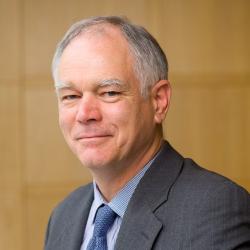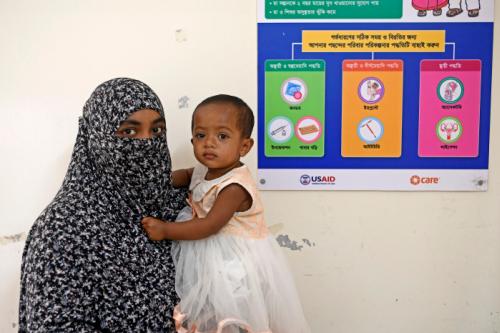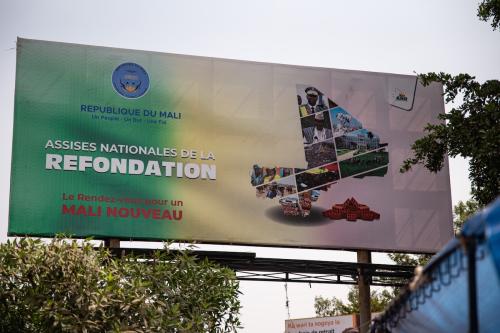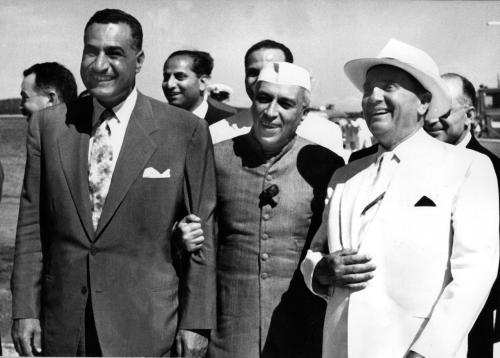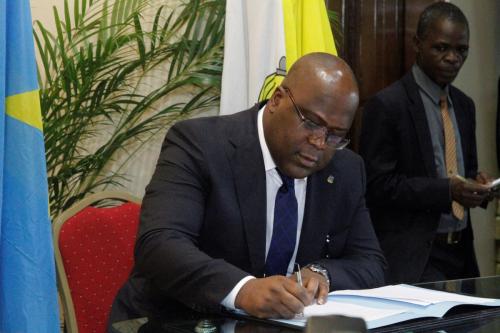One of the significant evolutions in international development over the past two decades has been the increasing commitment by bilateral donors, especially the United States, to locally led development (LLD). Abrupt recent changes in the global development policy landscape have generated widespread confusion and uncertainty regarding its future. In this context, it is worth taking stock of longer-term policy dynamics and how they might inform new paths forward.
As an approach, LLD recognizes the imperative of external funders to put leadership and agency in the hands of developing country stakeholders, rather than having donor priorities unduly drive programs and policy. Over a period of experimentation and increasing ambition, the development policy community has been cautiously optimistic about the steady if slow progress on LLD implementation. But the recent large-scale disruptions to assistance significantly threaten this progress and call the future of LLD into question. This essay draws upon our own analysis and two recent roundtable discussions to consider the broad arc of progress on LLD to date, with special focus on the U.S. policy context, and outlines some potential future directions.1
The long arc of locally led development
The core motivation of locally led development is for local stakeholders—government, civil society, business, academia, etc.—to drive the development of their own country. While various donors engaged to some extent in elements of LLD well before the concept became a standard in development practice, core principles were formally enshrined as development policy norms in the 2005 Paris Declaration on Aid Effectiveness.
For the United States, a 21st-century commitment to local ownership and LLD emerged and strengthened over four presidential administrations, two Democratic and two Republican. The terminology changed with each succeeding administration—country ownership, localization, journey to self-reliance, and locally led development—but the main concept remained consistent and grew in prominence. Through 2024, there had been steady progress in gradually shifting the locus of development assistance priority-setting and implementation to local stakeholders.
In its first manifestation, LLD was an underlying principle strongly reflected in the Bush administration’s creation of the Millennium Challenge Corporation (MCC) and the President’s Emergency Program for AIDS Relief (PEPFAR), even it was not codified or articulated as a stand-alone policy by the administration. The design of PEPFAR, launched in 2003, required that the program work through national and local health programs to deliver the medical care going to people with HIV/AIDS. The MCC, established the following year, was built on the principle of partner countries (rather than a U.S. government agency) proposing the content of a compact, with implementation and oversight by a national organization (rather than a U.S. entity).
The Obama administration subsequently set a first-ever public benchmark for LLD, setting a goal as part of its USAID Forward initiative that 30% of USAID’s funding go to local actors. While USAID made only modest progress toward the goal during the administration, significant changes to procurement and new policy guidance for missions created momentum for USAID leadership in the field to elevate LLD as a key priority.
The first Trump administration built on that foundation and articulated LLD as the Journey to Self-Reliance, creating metrics for determining the readiness of a country to decrease its dependency on U.S. assistance and pay for its own development. The administration’s policy framework laid out a pathway for strengthening a country’s capabilities and leadership—not just its government, but also among its private sector, civil society, and citizens—and outlined the role of USAID in supporting that journey.
The Biden administration then brought new ambition to the effort. In addition to setting a target that 25% of USAID’s funding goes directly to local organizations by 2025, it added a new dimension that, by 2030, 50% of the funding be driven by local priorities and design. LLD was specifically written into many Biden administration assistance policies, and some USAID missions made major strides in directing a majority of their funding to local organizations.
At the global level, LLD became a widely adopted policy priority. This is best reflected in the Donor Statement on Supporting Locally Led Development, assisted and facilitated by USAID. This simple pledge to integrate LLD into assistance programs has, as of early 2025, been signed by 20 official donors and 24 philanthropies.
Taking stock as of late 2024
While the policy commitment to LLD became a dominant theme in the development discourse over the past two decades, concrete implementation remained imperfect. Even by the end of 2024, there continued to be a range of views on priorities and how to measure progress, especially what types of assistance lend themselves to LLD and what organizations should qualify as local. While most OECD-DAC donors had philosophically adopted core principles aligned with LLD, and discussions on how best to achieve those aspirations remained vibrant, progress in increasing the amount of funding flowing directly to local organizations or moving decisionmaking and power to local stakeholders was halting. The vast majority of official development assistance (ODA) still moved outside an LLD framework.
By its own calculation, USAID had demonstrated slow progress in meeting its target to have 25% of funding go through local systems, achieving only 12% by 2024. Analysis by Publish What You Fund (PWYF) and Oxfam suggested an even lower rate of success. At the same time, the 2024 PWYF report “Commitments without Accountability” determined that USAID was the only one of five major bilateral donors (Australia, Canada, Netherlands, U.K., and U.S.) to write an LLD strategy and set targets. USAID was also deemed to have attained some success in increasing the level of input received from local stakeholders and encouraging other donors to elevate LLD as a policy priority. A subsequent 2025 PWYF report, Metrix Matter III, found that the same five bilateral donors had an average of 5.5% of project-type funding going directly to local organizations, ranging from the Netherlands at 6.9% to USAID at 5.1%. Meanwhile, the extent to which Northern philanthropies are directing their own resources to locally led development remains difficult to discern, as a recent study reported that few publish data on local funding.
Recognizing this imperfect progress, the Brookings Center for Sustainable Development hosted a December 2024 multistakeholder roundtable to take stock of long-term efforts and surface suggestions for next steps in advancing LLD. While the wide-ranging discussion focused principally on USAID, the insights and recommendations proved relevant to all donors, public and private, committed to LLD. Box 1 describes some of the key points raised in the discussion, which captured a sense of bipartisan progress on LLD in recent decades, while also raising many specific potential areas for ongoing improvement.
Box 1: Selected insights from December 2024 Brookings roundtable on locally led development—stocktaking and what’s next
On December 17, 2024, the Center for Sustainable Development (CSD) at Brookings convened a multistakeholder roundtable to take stock of the long arc of progress in advancing locally led development, particularly as related to USAID, and potential forward-looking priorities. A mix of actors from recent Republican and Democratic administrations shared insights alongside representatives of Northern and Southern civil society organizations and bilateral donors.
A wide-ranging discussion highlighted differing views around issues like the merits of quantitative targets for LLD. Nonetheless, some key takeaways emerged, including:
- Donors generally create definitions of local entities that suit their own operations, rather than being guided by Global South stakeholders as to what should qualify.
- Donors need to engage Southern stakeholders on how to shift the accountability of their locally funded partners toward the community they seek to serve.
- Rather than donors writing their own country strategies, an improved “localized” approach would base programs on the development strategies and policy priorities of Southern countries donors find compatible with their own approach to development.
The engagement surfaced several other key ideas and principles that donors could pursue for successfully advancing and supporting locally led development. One suggestion struck at the heart of what it means to be “local”—the need to ensure that the definition excludes entities that are not fully local but is broadened to cover support to governmental entities. Another recommendation was that decisionmaking should move from headquarters in the donor capitol to country offices, which have closer relations with local stakeholders, and funding should shift primarily to grants, which by their nature more easily align with the missions and programs of recipients. The field would benefit greatly from more ex-post evaluations that assess how and in what ways LLD strengthens development outcomes. To make this possible, donors could increase the number and training of staff dedicated to LLD, expand the authorities of local staff, and work to shift organizational cultures to be more in tune with LLD.2
The need to address complex, burdensome, time-consuming procurement processes generated a range of suggestions. These included more open solicitations, more awards that are restricted to local entities only, and expedited procedures that strip away the underbrush of compliance. A move to non-project assistance and performance-based awards could introduce more innovation in implementation, as would grant assistance. Local experts on technical evaluation committees would bring local experience and views to assessing proposals and reduce the burden on mission staff. Greater tolerance for risk would open awards to more creative local proposals.
Further details are available in a meeting summary published separately.
A disrupted landscape for development assistance
The suggestions articulated in late 2024 collided with significant U.S. policy shifts that occurred quickly and abruptly in early 2025, placing tremendous uncertainty around the future progress of LLD as a pillar of cross-border support. The most widespread and deeply felt changes resulted from the steps taken by the Trump administration to dismantle the infrastructure of U.S. development assistance. In its first few months, the administration shuttered most of USAID’s operations—firing or putting on administrative leave most of its staff, terminating some 10,000 awards, and freezing the payment of most bills due. The impact on the U.S. development sector has been deep, with most USAID implementers (many if not all of whom have been on the front lines of advancing LLD) making drastic decisions to cut staff, programming, and operations based on the administration’s actions.
The abrupt U.S. actions had profound consequences throughout the Global South. Many of these were discussed in a second CSD roundtable convened on February 10, 2025, as described further in Box 2.
The administration formally notified Congress on March 28 of its intent to abolish USAID and disperse its programs to various bureaus and offices in the Department of State; the termination of almost all USAID staff—including local staff—and closure of USAID overseas missions immediately clouded the future of LLD. That Congressional Notification reported that only 898 awards and 421 service contracts would be continued. Subsequently, on May 29, the administration submitted an additional notification that it would significantly reorganize the bureaus and offices across the Department of State, identifying where it intends to integrate specific USAID offices and functions into the Department.
The administration also moved to close or severely reduce funding of other U.S. government-backed entities, including MCC, the U.S. Institute of Peace, the Inter-American Foundation, and the African Development Foundation, the latter two being U.S. exemplars of LLD practices. The administration’s FY2026 “skinny budget,” released on May 2, suggests it may be turning to private-sector financing as its primary assistance tool, given its proposed substantial increase in resources for the U.S. Development Finance Corporation.
Yet the cutbacks and restructuring of U.S. development and humanitarian assistance programs is not unique. Over the past fifteen years, Australia, Canada, and the U.K merged their independent aid agencies into their foreign ministries. Several donors have also recently initiated major cuts to official development assistance, including Finland, France, Germany, the Netherlands, Norway, Sweden, and Switzerland. With global ODA falling 7% to $ 212 billion in 2024, and projected by the OECD to fall an additional 9-17% in 2025, the 2023 total of $223 billion could well stand for some time as the high watermark for ODA. In some countries, a large share of remaining ODA budgets is allocated to funding the domestic settlement of refugees, rather than country programmable assistance that can be used in developing countries.
Furthermore, the distinction between developed and developing countries is increasingly a misnomer of the past, with many countries of the traditional Global South contributing development finance to other countries and having the capability and political will both to govern their own development destiny and to influence global debates. This means ODA, at least in the classic sense, is a relevant tool for a narrowing set of geographies, even if still essential for many country contexts and global challenges.
The cumulative result of these recent development policy shifts is a sense that the post-World War II era of international development cooperation has, for the most part ended, and that the world is entering a new era. Heightened geopolitical tension, escalating violence and fragility, historic levels of human migration, conflicting visions of underlying political and economic principles, and the need to prepare for the next global pandemic are disrupting and pushing to the background attention and traditional approaches to development. Particularly problematic for LLD is the shift of the Trump administration, and possibly other donors, to a more transactional and self-interested use of foreign aid, in place of the LLD approach, which would move power and decisionmaking into the hands of local development partners.
Box 2: Global South perspectives on rapid cuts in US foreign assistance
On February 10, 2025, the Brookings Center for Sustainable Development convened a roundtable focused on Southern perspectives on the dramatic shifts in U.S. foreign assistance. As described in a separate meeting summary, the negative consequences loomed large. Roundtable participants conveyed how the rapidly perceived decline in support for global development created immediate concerns that will stretch the resources and capabilities of local actors and leaders, while raising questions about whether LLD can maintain its prominence as a key policy pillar when cross-border financial flows do occur.
At a human level, discussants worried about large numbers of lives, perhaps counted in the millions, being put at risk by losing access to life-saving food, medical care, and livelihoods. At the organizational and institutional level, hundreds of local businesses and civil society organizations were reported to be facing financial uncertainty and potential shutdown. Ripple effects include local organizations that receive only a small portion of their funding from the U.S. or simply work with U.S.-supported entities but rely on those entities for information and connections.
At the strategic level, some participants suggested that confidence and trust in the U.S. as a dependable ally is being broken, and that, by association, solidarity has been damaged among a range of partners engaged in supporting and investing in local actors as the primary protagonists in global development. Several roundtable participants described aid cutbacks as revealing the colonial nature of aid, since it highlighted the resources being more about the donor than the recipient and thereby reinforced the importance of local control of development efforts.
Potential pathways forward for LLD
It will likely take several years to discern the longer-term implications of recent donor policy changes toward lower-income countries, including what they mean for LLD. It is conceivable that in some countries, especially middle-income countries, the pullback of international support could catalyze greater local government accountability that, in turn, fuels accelerated development progress. It is also conceivable that many low- and middle-income countries will face a lost decade or more of progress, due to the abrupt nature of the cuts alongside the deep challenge of building systems to replace them, and the worsening fiscal and macroeconomic outlooks linked to debt.
Amid so much international uncertainty, one can still outline several principles and guiding questions to inform future efforts.
First, as an overarching principle, this is not a moment for tinkering with the inadequacies of what has been the international development architecture. It is a big picture moment for looking to the future to construct a new framework, or systems of structures, based on what works and that is relevant to current policy dynamics, and how these are likely to evolve over the next decade.
A second principle is that LLD is not seen as partisan; in the U.S. and other countries, it is typically seen as a technical—rather than political—issue. Over more than two decades, successive administrations have refined the policy contours and metrics toward a common ambition of supporting locally owned pathways to greater economic independence and self-reliance, largely because locally led development helps achieve better development outcomes and is more sustainable. And despite the U.S. having caused major disruptions to global development efforts in 2025, the arc of U.S. efforts for LLD up to that point rate well when compared to those of other countries.
Third, the approach to LLD needs to follow a path to mutually beneficial progress in a world that is increasingly based on geopolitical competition and transactional relationships. Crucially, this needs to be anchored in what Global South stakeholders say they need from Northern partners, public and private. The use of the term “partner” instead of “donor” is intentional; the new relationship must be more peer-to-peer and less characterized as a Northern entity providing aid to a Southern entity. One can think of such a framework as “demand-driven” rather than “supply-driven.”
Fourth, there are many pathways to LLD, many of which might not depend on traditional aid structures. In an extreme thought experiment, a world with no foreign aid would leave lower-income countries entirely in the hands of global markets and local leadership. This is not to argue against aid—far from it—but only to clarify the complexity of the underlying issues. Private remittances might present an opportunity for sustainable support—one model being hometown associations, voluntary organizations comprised of immigrants from the same town that engage in activities to support their community back home. Alternately, digital cash transfers for people in extreme poverty, such as through non-profits like Give Directly or public sector support programs, could form the ultimate shape of LLD, putting complete agency into individuals’ own hands. In still other cases, international progress on infrastructure financing or similar efforts to boost the private sector and local economic growth might empower the most enduring forms of local ownership and domestic resource mobilization.
Fifth, as larger development policy shifts evolve, a range of practical questions will continue to emerge that will define future LLD efforts. For example:
- If traditional ODA continues to decline as the dominant pathway for supporting development, what role will LLD play in other areas of development finance?
- How and in what contexts can Northern development intermediaries transition from implementers to facilitators, accepting the lead of Southern partners?
- How does humanitarian assistance successfully move to local entities, and what is the appropriate role of legacy international organizations in effecting that change?
- As shifts in ODA and even private philanthropy continue to occur, how can Southern partners leverage this assistance while strengthening their independence and self-sufficiency without being subject to the whims of the providers?
Leaders concerned about LLD must view the issues from several different perspectives, accounting for the evolving approaches of Northern donors, Southern partners, and non-ODA finance. Some Northern donors will continue along a more traditional approach, balancing self-interested national objectives with an understanding that advancing development in all countries falls within their national interest. In this context, LLD can be strengthened by having a clear, targeted definition of what constitutes a local entity, moving funding decisions to country offices, and simplifying procurement and accountability requirements.
As other donors—such as the United States under the new Trump administration—appear to move toward a more transactional approach for their foreign aid, LLD need not be lost. The Trump administration, for example, is pursuing an anti-elitist ideology—from its perspective, INGOs, development contractors, and universities are elite institutions. As it seeks inexpensive and efficient ways to do business, LLD may provide a useful alternative to what it considers to be the established development industry. Having said that, local priorities in lower-income countries seem unlikely to be a priority in the administration’s worldview, where global relations are driven by economic and military power. Moreover, the significant reductions to USAID staff and country missions raise questions about the ability of the U.S. to partner with local organizations.
As to the direction in which the South is headed, a range of potential dynamics emerged in our roundtables that have also been articulated in other convenings. One is that countries of the Global South may become equally transactional around ODA in demanding a quid pro quo that fits their own priorities. Another is that the South can simply continue to take charge of its future, sometimes articulated as “Africa for Africa.” Third, Southern countries are focusing not just on aid, but also on trade, investment, and the broad sweep of dynamics that affect development progress within and among countries. Putting these dynamics together means that countries of the Global South are increasingly motivated to be less dependent on Northern support and direction as they take responsibility for the nature of their governance and economies. Northern donors will be called upon to alter any restrictions that constrain this movement.
ODA may have reached a high point in 2023. The prospects of returning to that level are not encouraging. As development flows continue to evolve, countries are likely to explore diverse alternative sources of development finance—whether diaspora remittances or philanthropy, private, non-concessional, or concessional finance. Yet the path seems set that the largest source for most countries will continue to be their own local revenue, described in development circles as domestic resource mobilization (DRM).
Such an environment leaves the concept of LLD in murky waters. Certainly, Global South stakeholders have even more motivation to define the contours of their future for themselves. While the resources of Northern private philanthropy and international non-governmental organizations are limited compared to ODA, their convening power, freedom to innovate, and potential moral compass give them a source of trust and voice beyond their resources. Collectively, they have some agency to move beyond aid to a broader development frame that centers Southern voices and seeks to put Southern stakeholders at least on a peer level with Northern counterparts. To what extent a similar relationship takes hold among Global Northern and Southern governments will depend upon how a reenvisioned environment for global development solidarity emerges—and who is leading the charge.
-
Acknowledgements and disclosures
With appreciation to John McArthur for his editorial contributions.
The Brookings Institution is a nonprofit organization devoted to independent research and policy solutions. Its mission is to conduct high-quality, independent research and based on that research, to provide innovative, practical recommendations for policymakers and the public. The conclusions and recommendations of any Brookings publication are solely those of its author(s), and do not reflect the views or policies of the Institution, its management, its other scholars, or the funders acknowledged below.
Brookings gratefully acknowledges the support of the Conrad N. Hilton Foundation.
Brookings recognizes that the value it provides is in its absolute commitment to quality, independence, and impact. Activities supported by its donors reflect this commitment.
-
Footnotes
- Other recent related Brookings publications by Ingram and colleagues include: Locally led and globally informed: Key themes on localization, Development interdependence: locally driven, globally informed, and Obstacles and recommendations for moving U.S. development policies onto a locally led path.
- For additional analysis and recommendations for how to support local civil society organizations, see the report by Bond FCDO Engagement Report on Shaping the Future of Centrally Managed Civil Society and Civic Space Programming; NEAR’s Localization Performance Measurement Framework; Peace Direct’s The Nine Roles that Intermediaries Can Plan in International Cooperation.
The Brookings Institution is committed to quality, independence, and impact.
We are supported by a diverse array of funders. In line with our values and policies, each Brookings publication represents the sole views of its author(s).
